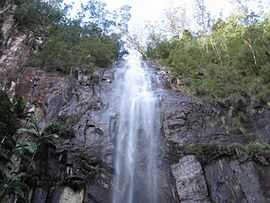Nightcap National Park
| Nightcap National Park New South Wales | |
|---|---|
|
IUCN category II (national park) | |
|
Protestor Falls, Terania Creek section, Nightcap National Park | |
 Nightcap National Park | |
| Nearest town or city | Lismore |
| Coordinates | 28°32′38″S 153°17′35″E / 28.54389°S 153.29306°ECoordinates: 28°32′38″S 153°17′35″E / 28.54389°S 153.29306°E |
| Established | 22 April 1983 |
| Area | 81 km2 (31.3 sq mi) |
| Managing authorities | National Parks and Wildlife Service (New South Wales) |
| Website | Nightcap National Park |
| See also |
Protected areas of New South Wales |
Nightcap National Park is in New South Wales, Australia, 35 km north of Lismore. It is classed by the IUCN World Commission on Protected Areas as Category II. It is part of the Shield Volcano Group of the World Heritage Site Gondwana Rainforests of Australia inscribed in 1986 and added to the Australian National Heritage List in 2007.
Geography
The park features a massif of peaks, ridges and gullies on the southern edge of the Mount Warning erosion caldera. The landscape in which the park is situated has developed from the erosion of a large shield volcano known as the Tweed Volcano. In places the range rises to more than 900 metres and is one of the state's wettest places.[1]
Flora and fauna
The park is home to a rich diversity of threatened plants and animals including; The Nightcap Oak Eidothea hardeniana (discovered in 2000), the Peach Myrtle Uromyrtus australis and The Minyon Quandong Elaeocarpus sedentarius. The Nightcap and nearby Koonyum Ranges are the only place on earth where the Peach Myrtle and Nightcap Oak can be found, while the Minyon Quandong is virtually endemic and is only known from a single tree outside these ranges. Threatened frogs include Fleay's Barred Frog and Masked Mountain Frog Philoria loveridgei.
Birds
The park lies within the Nightcap Range Important Bird Area, so identified by BirdLife International because it contains the largest known population of vulnerable Albert's Lyrebirds, as well as several other significant bird species.[2]
Access
The park has three main sections. Access to the Mount Nardi section, including Tuntable Falls and the Pholis Walk to Pholis Gap, is via sealed road from Nimbin. The park contains Old Googarna walking track past Mount Neville, and the Historic Nightcap Track from Doon Doon south through the Whian Whian SCA to Dorroughby or east to Huonbrook and Mullumbimby. From Dunoon via The Channon along Terania Creek Road vehicle access is possible to the Terania Creek Basin and a walk to Protesters Falls. Terania was the site of one of the biggest conservation battles of the late 1970s.[1] Also in the Whian Whian State Conservation Area, Minyon Falls is a 100m waterfall which rises from a subtropical rainforest valley. It has some popular walking tracks and a road-accessible lookout and picnic area.
See also
References
- ↑ 1.0 1.1 Hema Maps (1997). Discover Australia's National Parks. Milsons Point, New South Wales: Random House Australia. p. 144. ISBN 1-875992-47-2.
- ↑ "IBA: Nightcap Range". Birdata. Birds Australia. Retrieved 2011-08-30.
External links
| Wikimedia Commons has media related to Nightcap National Park. |
- Department of Environment, Climate Change and Water - Nightcap National Park
